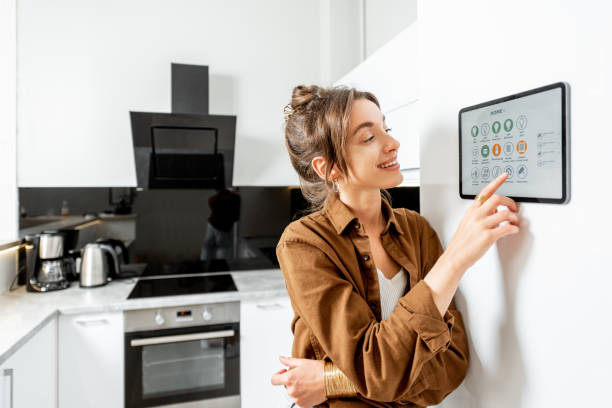Smart Home Automation is reshaping the way we deal with living spaces. With a simple voice command, one can control lights and thermostats, and monitor home security remotely, among other possibilities. Here, we will discuss smart home technologies in detail, covering their advantages, implementation approaches as well as upcoming trends.
Advantages of Smart Home Automation
1. Convenience
Think of getting home to a welcoming illuminated environment that is ideally temperature-controlled without making any effort at all. The smart home automation systems enable control of the different devices from smartphone apps or voice assistants like Amazon Alexa and Google Assistant.
Voice Control: Voice activated devices, for example smart speaker units and virtual assistants allow users to control their entire home setting through simple voice commands. For instance, “Ok Google, turn off the lights” will correctly turn the lights off in the whole house.
Remote Access: It doesn’t matter whether you are at work, on vacation, or relaxing in the backyard; remote access of smart home devices brings unprecedented convenience. Via mobile apps that are dedicated, users can track and edit settings from wherever in the world they have internet access.
2. Energy Efficiency
Homeowners are able to optimize the use of energy through smart thermostats, lighting systems and appliances and consequently reduce their utility bills. Technologies that are intelligent can automate the settings depending on occupancy, weather conditions, and daytime, thus optimizing energy usage.
Energy Monitoring: Most smart home gadgets feature energy monitoring functionalities allowing users to see instant data on how much electricity they are using. Through identification of energy-intensive appliances and behaviors, users can ensure to discard wastage and reduce their carbon footprint.

Scheduling and Automation: Intelligent thermostats and lights offer users a possibility of programmed schedules and automation scenarios. For example, scheduling the thermostat to lower the temperature when the house is unoccupied or programming lights to switch off automatically when not in used can save energy substantially over time.
3. Enhanced Security
With smart home security systems, you enjoy a peaceful mind as they offer real-time monitoring, intrusion/fire/environmental alerts. Integrated cameras, motion sensors, and smart locks which enable remote access and control provide homeowners with round-the-clock surveillance of their property wherever they may be.
24/7 Monitoring: Using smart security cameras and sensors, homeowners can now keep an eye on their property 24/7, with instant alerts for any strange occurrences or emergency. Such close monitoring acts as a discouragement to possible interlopers and provides timely information in case of a robbery.
Smart Locks and Access Control: Smart locks provide an increased level of security and convenience by enabling users to lock/unlock doors from anywhere using a smartphone app. Furthermore, supplementary access codes and activity records grant more authority and clarity into who comes and leaves the property.
Implementation of Smart Home Automation
1. Hub and Ecosystems Selection
Begin by deciding on a central hub or an ecosystem you will base your smart home around. Among the widely used alternatives are Amazon Echo, Google Nest, Samsung SmartThings, and Apple HomeKit. Think in terms of compatibility, support for devices and usability.
Compatibility: Make sure that the smart home hub you select is compatible with the devices you own or you are going to buy. Look for hubs that support a wide range of protocols, for instance Wi-Fi, Zigbee, and Z-Wave, to ensure compatibility.
Device Support: Get acquainted with the available devices and accessories which are compatible with each hub. Take into account the device quality, brand reputation, and the features that exactly meet your needs and tastes.
2. Device Integration
Choose your hub and then integrate all the compatible smart devices into your home network. It might range from smart thermostats, lighting systems, security cameras, door locks, smart appliances, and entertainment systems among other things. Take care that any device is correctly set and linked to the hub for smooth operation.

Installation and Setup: Follow up each smart device installation and setting procedure as mentioned by the manufacturer. Bear in mind of any compatibility requirements, firmware updates, or network settings that might be needed for correct operation.
Testing and Troubleshooting: After installing every device, perform a full testing to ascertain that the device functions as intended. Troubleshoot any issues or connectivity problems as soon as possible to avoid disruptions in the smart home ecosystem.
2. Automation and Customization
Use automation features to design your own routines and scenarios filed to the lifestyle you like. Another instance is that you can create “good morning” and “good night” routines to control lighting, temperature, and security devices automatically. Put the enhanced automation rules to the test to take energy savings and comfortability to another level.
Smart Scenes and Routines: Most smart home hubs come with default elements for creating custom scenes and routines. They enable users to control a number of devices at once with a single command or a triggerer, thus making daily tasks and routines more efficient.
Integration with Third-Party Services: Look into integrations with commonly used third-party services and platforms to widen the scope of your smart home system. For one, you can associate smart lights to music streaming services so the lights go with your favorite music.
The Future Directions in Smart Homes Automation
1. Artificial Intelligence Integration
The development of artificial intelligence(AI) will make smart home devices more intelligent and adaptive. AI-based assistants will learn user tastes and will foresight their needs, presenting personalized suggestions and automations.
Machine Learning Algorithms: AI algorithms will analyze user behaviors including environmental data in order to set and run the automation routines and device setting on its own. A smart thermostat could learn the user’s temperature preferences and automatically adjust to that without any manual adjustments.
Natural Language Processing: One of the things that will foster more conversational interaction is advancement in natural language processing (NLP). They can also expect voice commands that are natural and intuitive as well as contextual comprehension of their demands and preferences.
2. Focus on Sustainability
There will be a growing focus on energy efficiency and eco-friendly operations with the rising environmental sustainability concerns and smart home technologies. In future smart home products, anticipate more energy-saving features, renewable energy integration, and eco-friendly designs.
Renewable Energy Integration: More and more Smart home systems will integrate renewable energy sources like solar power, wind turbines, and geothermal heating. The systems implement power optimization techniques, aimed at minimizing dependence on traditional grid electricity.
Energy Management Solutions: The advanced energy management solutions shall give homeowners the details and give suggestions on how to reduce the energy usage and carbon emissions. The solutions can be smart energy meters, real-time energy monitoring and predictive analytics.
Last Words
Smart home automation brings about a lot of advantages such as high convenience, energy efficiency, security as well as sustainability. Through the adoption of smart technologies and fusion with our living environments, we can develop homes that are safer, more comfortable, and more efficient than ever before. Take the first step towards a smart home today and become a witness to the future of living.

